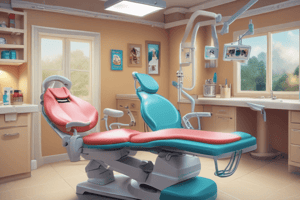Podcast
Questions and Answers
Which of the following is NOT considered a retentive component of a removable orthodontic appliance?
Which of the following is NOT considered a retentive component of a removable orthodontic appliance?
- Springs (correct)
- Clasps
- Acrylic base plate
- All of the above are retentive components
What is the primary function of the acrylic base plate in a removable orthodontic appliance?
What is the primary function of the acrylic base plate in a removable orthodontic appliance?
- To provide retention and hold the appliance in the mouth
- To exert active forces for tooth movement
- To provide anchorage for tooth movement
- To act as a major connector between the appliance components (correct)
Which of the following is an example of an active component in a removable orthodontic appliance?
Which of the following is an example of an active component in a removable orthodontic appliance?
- Clasps
- Acrylic base plate
- Elastics (correct)
- None of the above
What is the primary function of the anchorage component in a removable orthodontic appliance?
What is the primary function of the anchorage component in a removable orthodontic appliance?
Which of the following is NOT considered an active component in a removable orthodontic appliance?
Which of the following is NOT considered an active component in a removable orthodontic appliance?
What type of movement is described as mesial/distal in the context of orthodontics?
What type of movement is described as mesial/distal in the context of orthodontics?
In orthodontics, what is the purpose of using elastics despite their rapid deterioration in the mouth?
In orthodontics, what is the purpose of using elastics despite their rapid deterioration in the mouth?
What function do elastics serve in orthodontic appliances?
What function do elastics serve in orthodontic appliances?
Which component is commonly used in orthodontics for creating space but is not always available as an alternative to elastics?
Which component is commonly used in orthodontics for creating space but is not always available as an alternative to elastics?
What is the primary reason for using elastics despite their quick deterioration inside the mouth?
What is the primary reason for using elastics despite their quick deterioration inside the mouth?
What is the primary function of active removable orthodontic appliances?
What is the primary function of active removable orthodontic appliances?
Which of the following is an example of an active component in a removable orthodontic appliance?
Which of the following is an example of an active component in a removable orthodontic appliance?
What is the purpose of using elastics in conjunction with a removable orthodontic appliance?
What is the purpose of using elastics in conjunction with a removable orthodontic appliance?
Which component of a removable appliance is responsible for retaining the appliance in the mouth?
Which component of a removable appliance is responsible for retaining the appliance in the mouth?
What is the primary disadvantage of using elastics with a removable orthodontic appliance?
What is the primary disadvantage of using elastics with a removable orthodontic appliance?
Flashcards are hidden until you start studying
Study Notes
Retentive and Active Components of Removable Orthodontic Appliances
- Retentive components help to secure the appliance in the mouth; an example of what is NOT a retentive component is provided in the context.
- Active components actively influence tooth movement; specific examples are given in questions about their roles.
Acrylic Base Plate Function
- The acrylic base plate serves as the foundation of the removable orthodontic appliance, providing structural support and comfort for the wearer.
Anchorage Component
- The anchorage component is crucial for stabilizing the appliance and ensuring that the active elements can effectively move the teeth.
Mesial and Distal Movement
- Mesial movement refers to the movement of teeth toward the midline, while distal movement refers to movement away from the midline in orthodontic settings.
Purpose of Elastics in Orthodontics
- Elastics are used despite their rapid deterioration because they provide necessary force for tooth movement, enhancing treatment efficacy.
- They help in achieving desired tooth alignment and correcting malocclusions through consistent pressure.
Space Creation Alternatives
- While elastics are commonly used, springs may also be employed to create space within the dental arch, offering alternative methods for managing tooth positioning.
Disadvantages of Elastics
- A primary disadvantage of using elastics with removable appliances is their tendency to wear out quickly, requiring frequent replacement and potentially disrupting treatment progress.
Functions of Active Removable Appliances
- Active removable orthodontic appliances are designed to actively shift teeth into proper alignment, utilizing various components to exert controlled forces.
Studying That Suits You
Use AI to generate personalized quizzes and flashcards to suit your learning preferences.




